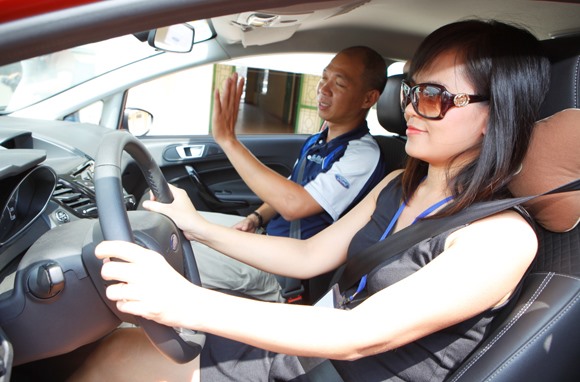 Society
Society

Many driving training centres in HCM City ignore regulations, and encourage learners to pay additional fees aside from tuition in return for guaranteed success in theory tests required for drivers’ licenses.
 |
| A learner out with her instructor. — Photo dayhoclaixe.edu.vn |
HCM CITY — Many driving training centres in HCM City ignore regulations, and encourage learners to pay additional fees aside from tuition in return for guaranteed success in theory tests required for drivers’ licences.
The fact that learners pass their tests, but lack essential skills to master their driving, makes accidents more likely to occur, posing a threat to people’s lives, Tuổi Trẻ (Youth) reported.
Bùi Thị Hoa, an office worker from HCM City, said that after establishing contact with a company specialising in training drivers in the city, she decided to register for a course to obtain a B2 driver licence .
She had to pay VNĐ5.5 million (US$241) for the course which included 32 hours of practice and four theory lessons.
She was guaranteed to pass theory tests without having to learn the lessons. However, she was asked to pay an additional VNĐ2.9 million ($127) for examination and licensing fees.
The centre would also take care of the compulsory health check-up with the cost of just VNĐ190,000, if she didn’t have time for it, she said.
Hoa said that she considered this a good thing, until she got the licence and realised that she lacked the necessary skills and knowledge to drive a car properly.
She often broke traffic laws and could not perform basic moves such as reversing or making a U-turn.
Finally, Hoa decided to purchase the necessary documents relating to driver training tests, and asked her friends to help her practise driving.
Nguyễn Thanh Tùng, a resident in Gò Vấp District, had similar experiences.
He picked up a VNĐ4 million ($175) course at a local training centre.
Tùng was told to contribute VNĐ1.5 million ($66) more to the centre if he wanted to make sure he would pass the theory test.
Upon agreeing to the compromise, Tùng didn’t have to do anything during the exam and the tests were done on the computers automatically, Tùng still passed the test.
The case of Phan Quốc Bảo, who lives in Phú Nhuận District, was a little different.
Bảo said he was given not enough time for practising, adding that he got only around ten hours of practice instead of the 20 hours stated in the registration paper.
“I didn’t know how to drive at the end of the course,” he was quoted as saying by the newspaper.
In response to Bảo’s queries, an employee at the driving centre said they had fulfilled their responsibilities and suggested that he register for another course if he failed in the test.
According to Trần Quốc Khánh, chief inspector of the municipal Department of Transport, the agency has received many reports involving irregularities at a number of local driving centres.
He said the department was working with relevant agencies including the Department of Labour, Invalids and Social Affairs and local authorities to carry out comprehensive inspections at these facilities.
Chairman of the Hà Nội People’s Committee Nguyễn Đức Chung has proposed to include traffic laws in the high school curriculum.
He said at a recent meeting with representatives from the Ministry of Transport that the introduction of traffic law into schools would give people a more thorough understanding of the law, giving them a higher chance of passing driving tests legitimately after they graduate.
According to Chung, most students in foreign countries obtain car driving licences at the age of 18, while students in Hà Nội in particular and Việt Nam in general haven’t even learnt about the traffic law.
Agreeing with Chung’s opinion, Khuất Việt Hùng, Vice Chairman of the National Committee of Traffic Safety (NCTS), said the committee had long pursued the goal of including road traffic law, as well as driving training courses into the high school curriculum.
While lauding the necessity of teaching traffic law at schools, Nguyễn Thắng Quân, head of Vehicle and Drivers Management Department under the Directorate for Roads of Việt Nam said that the driving licences should only be given out after a person is at least 18 years of age.
This is to ensure that they are responsible for their actions while driving cars or motorbikes, Quân told Thanh Niên (Young People) newspaper.
Trần Hữu Minh, deputy head of NCTS’s Office, said that the number of child-related traffic accidents in Việt Nam was high compared with average rate of other countries in the world.
For example, fatalities in traffic accidents among high school students in Hà Nội is 7.39 persons per 100,000 students, almost three times higher than in Japan, and almost twice as high as in South Korea.
Statistics from NCTS showed that high school students were involved as either drivers or victims in 80 per cent of child-related traffic accidents in HCM City.
“The teaching of road traffic law and organisation of driver training courses for high school students is necessary to overcome the problems of traffic accidents within this group,” Minh told the paper.
He emphasised that knowledge on traffic safety should be taught as early as kindergarten, and continued throughout primary and secondary schooling. However, Minh said, the granting of driving licences must be kept in accordance with the age stated in road traffic law, meaning that only those of at least 18 years of age are eligible.
Some parents voiced their disagreement with the proposal, saying that allowing students of under 18 years to take part in driving tests would be risky as they lack adequate physical strength and knowledge.
“As defined by the law, people of 18 years or over are eligible to take part in a driving test. It is necessary to increase supervision from both parents and schools to prevent students from violating traffic safety regulations,” said Vy, a resident in Hà Nội. — VNS




